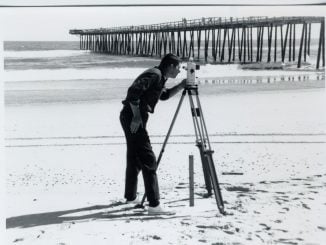
Aug. 30, 1983
Astronaut William Thornton and the Space Shuttle Challenger
History was made on Aug. 30, 1983, as Faison native William Thornton barreled into space from Cape Canaveral, Fla., aboard the shuttle Challenger. Born in Duplin County, Thornton received bachelor’s and medical degrees from UNC Chapel Hill and worked as an electronics engineer before entering the Air Force. It was during his two-year tour of duty with the U.S. Air Force that he became involved in space medicine research and subsequently applied for astronaut training. Thornton holds more than 35 patents that range in subject from military weapons systems to the first real-time EKG computer analysis. Among other things, he developed a treadmill for in-flight exercise and designed the first mass measuring devices for space, which remain in use today. A veteran of two space flights, Thornton logged more than 313 hours in space. After serving as a mission specialist on the shuttle Challenger in 1983, he held the same role on Challenger’s 1985 mission. He retired from NASA in 1994. In 2010, Thornton donated his priceless collection of documents and photos from his work in medical research, physics, electronics, the military and space to the State Archives.
Aug. 31, 1823
Jesse Franklin, governor from Surry County, dies
Former North Carolina Gov. Jesse Franklin died at his home in Surry County on this day at age 63. Born in 1760 in Orange County, Va., Franklin moved to North Carolina in 1776. He fought at the Battle of King’s Mountain and the Battle of Guilford Courthouse on the patriot side and rose to the rank of major. After the Revolution, Franklin served in the state legislature, representing both Wilkes and Surry counties before serving a single term in the U.S. House of Representatives and two terms in the Senate. In 1816, Franklin became part of a commission, with David Meriwether and Andrew Jackson, to negotiate settlements with the Cherokee and Chickasaw. By the time he was elected governor in 1820, Franklin was 60 yearsold. Despite his health issues, Franklin carried out his duties conscientiously and with his characteristic simplicity and practicality. He is perhaps best known for reforming the state’s penal code and advocating the settlement of the state’s borders.
Sept. 2, 1890
Elon University’s beginnings date to 19th century
Elon College opened as a four-year liberal arts college in Alamance County. Plans for the school had been underway since 1872, when what is now the United Church of Christ decided to open a college. The institution was first called Graham College, but when the trustees were unable to acquire land in that small Alamance County town, a different location for the campus was selected west of Burlington. When the land, filled with old oak trees, was being cleared, the name Elon seemed like a natural fit, since “elon” is the Hebrew word for oak. The community around the school grew quickly and was incorporated in 1893 as Elon College. The town’s streets were given names commemorating important figures in the development of the Christian Church and of the college. In January 1923, the main campus building was destroyed by fire. During the reconstruction, which took about three years, the campus was expanded with five new buildings. Elon College added graduate degree programs in the 1980s. To reflect the school’s diverse programs and growing student body, the college changed its name to Elon University in 2000. The surrounding town also changed its name — from Elon College to Elon.
Sept. 3, 1960
Wilbur Hardee opens restaurant in Greenville
In 1960, Wilbur Hardee opened a drive-in hamburger stand in Greenville, launching what would become Hardee’s Food Systems, the fifth-largest fast-food restaurant chain in the United States. The former Martin County farm boy and World War II Navy cook initially sold his charcoal-broiled hamburgers and milkshakes for 15 cents each, mainly to students at nearby East Carolina University. In 1961, Hardee took on two partners and opened a second restaurant in Rocky Mount. By 1963, the business had grown to a five-restaurant franchise. Hardee lost controlling interest in the operation that same year during a card game with his partners. He later sold his remaining shares for $37,000, but Hardee’s namesake eatery wasn’t his only endeavor. During his lifetime, he opened 85 restaurants throughout the Southeast, including Biscuit Town, Hot Dog City, and Beef and Shake. He also started another hamburger chain called Little Mint that grew to 25 locations in the Carolinas. But it was the Hardee’s chain that achieved the greatest success. In 1997, St. Louis-based CKE Restaurants bought Hardee’s, which last year boasted more than 2,000 locations worldwide and $1.8 billion in revenue. Hardee died in 2008 at age 89.
Sept. 2, 1952
Mile-High Swinging Bridge dedicated
On this day, Gubernatorial candidate William B. Umstead dedicated Grandfather Mountain’s Mile-High Swinging Bridge near Linville and became the first person to cross it. Earlier that year entrepreneur Hugh Morton inherited Grandfather Mountain, whose craggy features and high vistas made it a popular tourist attraction since the 1890s. Morton envisioned building a bridge between Grandfather’s Convention Table Rock and Linville Peak to improve visitors’ access to the best scenic overlooks. Designed by Greensboro architect Charles Hartmann Jr. and fabricated by Truitt Manufacturing Company in Greensboro, the 228-foot suspension bridge was reassembled in three weeks at Grandfather Mountain by Craven Steel Erecting Company. The total cost was $15,000. In 1999, the mostly wooden bridge was rebuilt using galvanized steel at a cost of $300,000. Former state tourism director Charles J. Parker coined the name “Mile-High Swinging Bridge” at the 1952 dedication. While the bridge’s elevation is slightly more than a mile above sea level, it actually hangs only 80 feet above the ground. While suspension bridges can swing, especially in high winds, thick cables anchor Grandfather Mountain’s bridge to the ground, limiting its movement.



